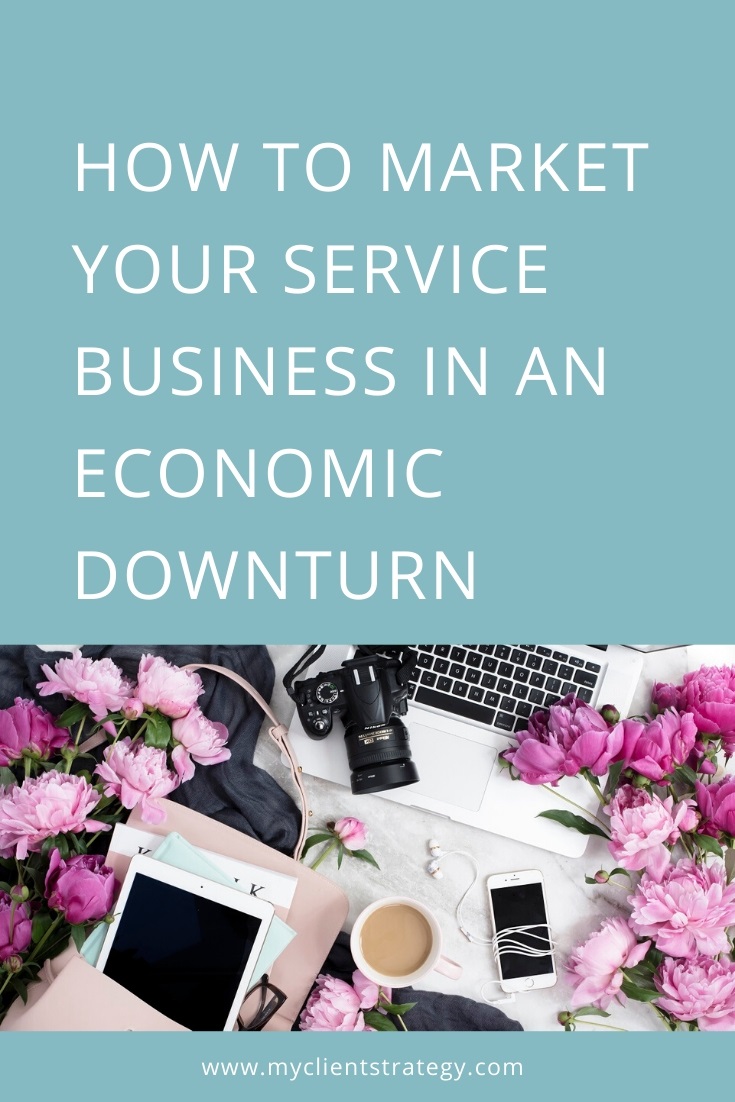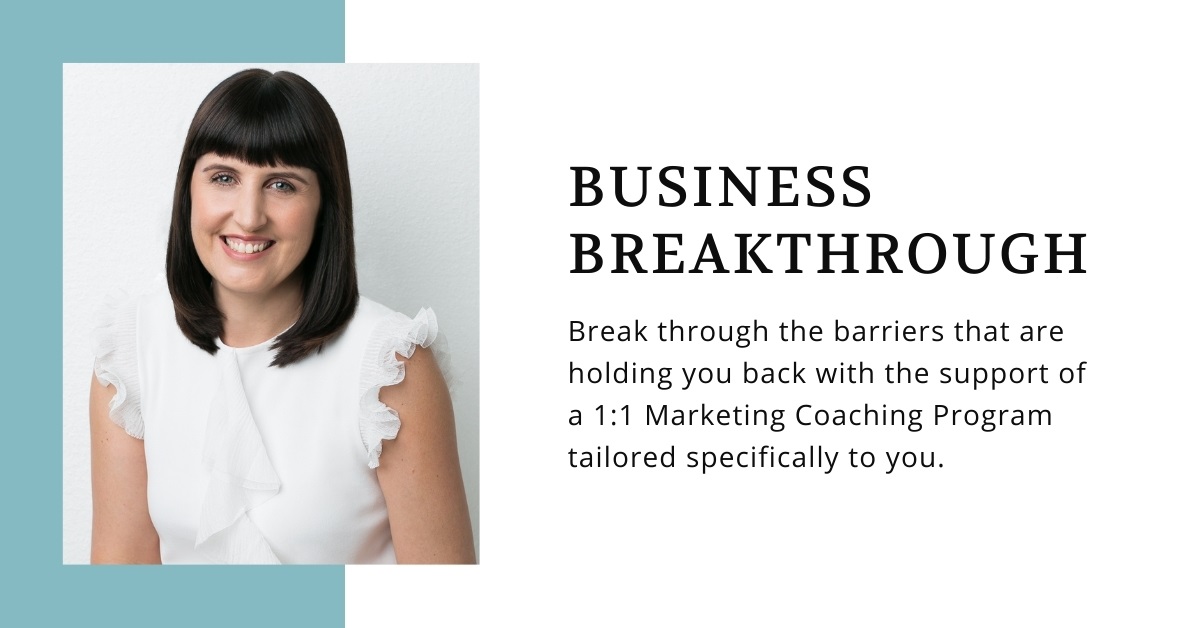How to market your service business in an economic downturn

Not sure where to start when it comes to marketing in an economic downturn?
Or what you can do to find clients when everything slows down, and people start to spend their money more cautiously?
It’s a challenge that I know many small business owners are facing right now.

As a small business owner myself, I know just how challenging it can be to generate leads and make sales in this environment.
However, there are several tactics and strategies that experienced marketers adopt during an economic downturn to keep their small businesses afloat.
In the blog article below, I share ten ways you can adapt to this changing market environment and drive sales in your service business.
Some of these will be more relevant to your small business situation and circumstances.
So, it’s important that you choose the ones which you feel best align with your marketing objectives.
And implement those which you believe will have the most significant impact when it comes to maintaining and improving your business performance.
10 simple steps you can take for marketing in an economic downturn:
1. Research your target market and competition
When the market conditions change, there’s a fair chance that the wants and needs of your target market will have changed too.
So, it’s critical that you understand what your ideal clients want and need now.
How have their pain points and challenges changed?
And, what solutions are most important now in this new market environment?
Reach out to past clients or survey your email list with a list of questions.
Or, publish check-in posts to gauge the mood of your followers on social media.
While demand has dropped away for certain types of services, there are also opportunities to create new services or shift to online delivery.
Market research will provide you with valuable insights as to what these opportunities may be.
Also, monitor your competition to see how their offers have changed and decide if you need to make any adjustments to stay competitive.
RELATED: Free Training – How to research your target market
2. Measure and track your key metrics
When your revenue is at risk, it’s important to cut unnecessary spending. But, not from your client-generating marketing activities!
As such, before you make any decisions on where to cut it’s essential that you know where your leads are coming from.
The best way to understand your marketing performance is to measure, track, and review your key business metrics.
Review where your most recent clients came from and analyse how they heard about you.
Also, ensure you have Google Analytics installed on your website so you can see which marketing channels are driving your website traffic.
If you don’t know how to find this information, go to the ‘Acquisition’ menu in Google Analytics, then, ‘All Traffic’ and then, ‘Channels’.
Align your marketing spend to the channels that you now know are driving traffic to your website, and cut spending in channels that aren’t bringing you leads.
Also, review your social media insights pages, your email marketing statistics, and your sales funnel conversion rates to identify other opportunities to improve your return on marketing investment.
RELATED: 7 Marketing metrics all service businesses should track
3. Maintain a consistent presence
If you’ve spent considerable time and money building your social media following and email list, then you won’t want to let your audience go ‘cold’.
Ensure that you continue to engage and nurture your leads so that when market conditions improve, you’ll have a ‘warm’ list to market to.
Send more regular emails, post on social media, engage with your followers, and collaborate with other businesses to increase your visibility.
It will be far easier to generate growth and get your business momentum back if you are still top-of-mind when your prospective clients are ready to buy again.
Not sure where to start when it comes to marketing your service-based small business? That’s where I can help. Get started by downloading my free Ultimate Marketing Checklist by clicking the button below:
4. Introduce new services
Use the target market research information you gathered and identify if there are new services that you could introduce.
For example, are there new service packages you could create at lower or higher price points than what you offer today?
Or, are there service guides, courses, workshops, or programs that you could create to share your knowledge with others online?
Alternatively, are there other services your industry provides that are more appropriate for you to switch to and promote?
Whatever services you choose to add or switch your focus to, be sure to choose and design your offers based on the insights your market research provided.
And run it past one of your past clients or business associates to gain feedback before you launch it.
RELATED: 15 Things you need to create an irresistible service offering
5. Use alternate distribution channels
In uncertain times when people are not going out and spending money, consider how you could deliver your services virtually online.
Online teleconferencing tools such as Zoom are great for delivering training or services to clients.
Or you could create a private Facebook group and run live group sessions with your clients.
If you’ve introduced online webinars or events, you can use platforms such as Eventbrite or Facebook to take registrations and/or payments.
RELATED: 30 Marketing tools all service-based business shoud know about
6. Negotiate to retain existing clients
If you have clients who are significantly impacted by this economic downturn, then it’s important to show empathy and keep the lines of communication open.
Proactively reach out to them and have an honest conversation about their circumstances.
It may be better for you to agree to a reduced service offering, discounted fee, or a deferred payment, rather than lose the client altogether.
You could also generate some serious goodwill for your business if you’re able to help your clients and show understanding when they need it most.
Your clients will remember who helped them during their time of need, and if you negotiate to find a win-win outcome, then you’ll likely have a client for life.
Not sure where to start when it comes to marketing your service-based small business? That’s where I can help. Get started by downloading my free Ultimate Marketing Checklist by clicking the button below:
7. Don’t wait for others to engage
Many people can sit back and be cautious about marketing in an economic downturn, but there is no need to be if you approach it in a considered way.
If you aren’t hearing from your audience or leads, then reach out to them instead.
Your marketing tactics may include things such as:
- Increasing the frequency of the emails that you send to your list
- Commenting on social media posts and sharing other people’s content
- Running free online webinars and inviting your audience to attend
- Showing up more often in your Facebook group or on IGTV and going live on video
- Sending DM’s to followers who you can see are highly engaged with your content
- Calling past clients to check in and see if there’s anything you can do to help them
- Running competitions and inviting your followers to enter
- Following or reaching out to connect with new connections on social media
It’s important to note that engagement is primarily for relationship-building and not for sales pitching. (That will come later).
As such, be authentic and genuine with your outreach approach so that you come across as helpful and not as spammy.
8. Boost your value proposition
Rather than impulsively applying discounts to drive sales, consider if you can add more value to your offer instead.
Are there additional sessions or appointments that you could add as bonuses or resources that you could include to provide extra value in your packages?
Perhaps you could increase your appointment length time or add an extra layer of support via phone or email, so clients can check-in with you if they need to at no additional cost.
When it comes to promoting the additional value, you can either market it as a bonus special.
Or announce that you’ve changed your service package to provide more value.
If you permanently change your value proposition during the economic downturn, then you can also increase your prices to reflect this greater value when conditions improve.
RELATED: 10 Ways to add a service-based bonus offer to boost sales
9. Use strategic pricing tactics
Limited time only price discounts can be an effective way to drive volume in the short term.
However, I recommend discounting your introductory or lower level services rather than your signature services, so that you don’t diminish the value or your core services.
Also, rather than dropping your prices permanently, be sure to use a promotional code so that you can remove the discount once market conditions improve.
Another pricing tactic that you can use to stimulate some short-term demand is to run a flash sale for a 24 or 48-hour period.
10. Adjust your payment terms
In an economic downturn where money is tight, you could also introduce new payment methods or change the terms around your payment plans.
If you only have cash payments or direct debit, sign up to Stripe or PayPal so your clients can also pay via credit card.
Where appropriate, you may also consider extending your payment plan from 3 months to 6 or 12 months for higher priced services.
When offering payment plans there is a risk that you could also see an increase in bad debts.
So, ensure that payment plans are only offered when a client signs up via an automated system where you have the direct debit control.
Now, I often hear service-based business owners tell me that they are too busy for marketing and can’t seem to find the time to keep their client pipeline filled.
However, this economic downturn may provide the perfect opportunity for you to use time strategically.
Set up your marketing systems now, so you’ll be far better positioned to attract clients and grow your business when things return to normal.
To provide some examples, you could use this time to create marketing templates, write blog articles, record podcast episodes, network with others, update your website, enhance your sales funnels, or build a new webinar or lead magnet to grow your email list.
These are all assets that you can use moving forward in your business and will help you scale more effectively over the longer term.
You could also spend this time upskilling and learning something new that will help you to grow your business.
There are several options available, including courses, masterminds, and group programs.
Or, you could opt to work with a coach on a 1:1 basis to upskill, drive improved performance, and grow your service business.
To learn more about the options I have to work together, click here.
Finally, remember that this economic downturn will pass, and market conditions will return to normal in time.
While it may feel uncomfortable now, focus on those practical things that you can do to adapt and keep serving your valued clients.
Tired of trying to figure out what you’re missing when it comes to finding clients and making sales in your service business?
Break through the barriers that are holding you back with the support of an MBA-qualified Marketing Coach and Business Mentor who will tailor a 1:1 program specifically for you.

BUSINESS BREAKTHROUGH is a 3 or 6-month 1:1 Coaching Program for service-based business owners who want to develop the strategy, systems, and structure they need to find clients and make sales, so they can stop feeling stuck and start gaining massive momentum in their business.
Did you find this post helpful? Please don’t forget to share on Facebook or PIN to Pinterest.



